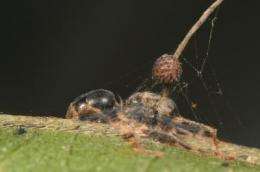Zombie ants have fungus on the brain

Tropical carpenter ants (Camponotus leonardi) live high up in the rainforest canopy. When infected by a parasitic fungus (Ophiocordyceps unilateralis) the behaviour of the ants is dramatically changed. They become erratic and zombie-like, and are manipulated by the fungus into dying at a spot that provides optimal conditions for fungal reproduction. New research, published in BioMed Central's open access journal BMC Ecology, looks at altered behaviour patterns in Zombie ants in Thailand and shows how the fungus manipulates ant behaviour.
A multinational team of researchers investigated O. unilateralis infected carpenter ants in Thailand's rainforest. The growing fungus fills the ant's body and head causing muscles to atrophy and forcing muscle fibres apart. The fungus also affects the ant's central nervous system and while normal worker ants rarely left the trail, zombie ants walked in a random manner, unable to find their way home. The ants also suffered convulsions which caused them to fall to the ground. Once on the ground the ants were unable to find their way back to the canopy and remained at a lower, leafy, 'understory' which, at about 25cm above the soil was cooler and moister than the canopy, provided ideal conditions for the fungus to thrive.
At solar noon (when the sun is at its strongest) the fungus synchronised ant behaviour, forcing infected ants to bite the main vein on the underside of a leaf. The multiplying fungal cells in the ant's head cause fibres within the muscles that open and close the ant's mandibles to become detached. This results in 'lock jaw' which means that an infected ant is unable to release the leaf even after death. A few days later the fungus generates a fruiting body (stroma) from the ant's head which releases spores to be picked up by another wandering ant.
Dr David Hughes, from Penn State University, said, "The fungus attacks the ants on two fronts. Firstly by using the ant as a walking food source, and secondly by damaging muscle and the ant's central nervous system, resulting in zombie walking and the death bite, which place the ant in the cool damp understory. Together these provide the perfect environment for fungal growth and reproduction. This behaviour of infected ants is essentially an extended phenotype of the fungus (fungal behaviour through the ant's body) as non-infected ants never behave in this way."
More information: Behavioral mechanisms and morphological symptoms of zombie ants dying from fungal infection, David P Hughes, Sandra Andersen, Nigel L Hywel-Jones, Winanda Himaman, Johan Billen and Jacobus J Boomsma, BMC Ecology (in press)
Provided by BioMed Central
















